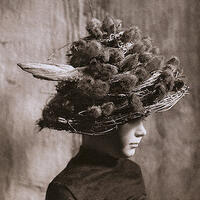 Harvard undergraduates! Looking for a well to relax, make art and be in a welcoming community? The Office for the Arts is offering a lineup of visual arts courses this fall for all skill levels. Also, meet the Narrative Photography instructor Anne Eder.
Harvard undergraduates! Looking for a well to relax, make art and be in a welcoming community? The Office for the Arts is offering a lineup of visual arts courses this fall for all skill levels. Also, meet the Narrative Photography instructor Anne Eder.
Anne Eder, an interdisciplinary artist and educator from Philadelphia, is part of the lineup of visual arts offerings through the OFA this fall. Her online class Narrative Photography -- with four-part courses that begin Sept. 15 and Oct. 13 -- is free and open to all

We often think of narrative as an oral tradition. How/why does the word resonate for you and your photography and sculpture?
My own work takes place in the intersection where the natural world meets the narrative impulse. My sculpture and installation work draws on fairy tale, myth and the role of the natural world in the formation of our core mythologies, folklore and belief systems. These are then translated into images using a variety of handmade photographic processes. There is no way to better engage someone than through an engaging and open-ended story.
What can students expect to discover in your class and what do they need to bring with them mentally and artistically?
Students during COVID are unhappy at being in lockdown, unable to go out and photograph new things, new places. I hope to help them to see their limited environments through fresh eyes by telling not only their important stories about this time in our history, but also their fantasies of the world if things were different. Our fictions help us to realize that obstacles may be overcome and keep the imaginative muscle in shape, which is essential to problem solving. Students need only bring an open mind, and some means of taking a photograph, be that a traditional camera or a smart phone.
When you were 17-21 (college age), how were the arts a part of your life and how did those years shape who you are today? What questions were you asking of yourself and the forms?
At that age, the arts WAS my life. I was working across mediums in experimental photography, and in music, in about equal parts. I did not come from privilege, and access to some institutionalized art forms was prohibited for me. Increased arts access has been a major concern of mine throughout my life and the production of public art is a dedicated part of my practice. At college age, I was not in college but was a young single mother and a working artist, only returning to get my degrees later. That period of immersion in the arts and motherhood made me the nontraditional artist that I am today. I did return to receive both my bachelor’s degree and my MFA in Photography and Integrated Media.